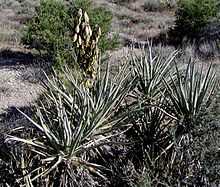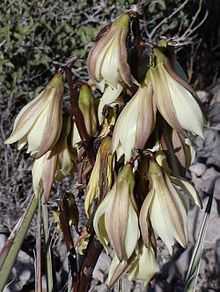Yucca baccata
| Banana yucca | |
|---|---|
 | |
| Yucca baccata at Red Rock Canyon | |
| Scientific classification | |
| Kingdom: | Plantae |
| Clade: | Angiosperms |
| Clade: | Monocots |
| Order: | Asparagales |
| Family: | Asparagaceae |
| Subfamily: | Agavoideae |
| Genus: | Yucca |
| Species: | Y. baccata |
| Binomial name | |
| Yucca baccata Torr. in Emory[1] | |
| Synonyms[2] | |
| |

Yucca baccata (Datil yucca or Banana yucca) is a common species of yucca native to the deserts of the southwestern United States and northwestern Mexico, from southeastern California north to Utah, east to western Texas and south to Sonora and Chihuahua. It is also reported in the wild in Colombia.[3]
The species gets its common name "banana yucca" from its banana-shaped fruit. The specific epithet "baccata" means "with berries." Banana yucca is closely related to the Mojave yucca (Y. schidigera), with which it is interspersed where their ranges overlap; hybrids between them occur.
Yucca baccata is recognized by having leaves 30–100 cm long with more of a blue-green color, and short or nonexistent trunks. It flowers in the spring, starting in April to July depending on locality (altitude), and the flowers range from 5 to 13 cm long, white to cream with purple shades. The flower stalk is not especially tall, typically 1–1.5 meters. The seeds are rough, black, wingless, 3–8 mm long and wide, 1–2 mm thick; they ripen in 6–8 weeks. The indehiscent fleshy fruit is sweet, 8–18 cm long and 6 cm across, and cylindrical.
The Paiutes dried the fruits for use during the winter.
Subspecies
Yucca baccata has been divided into three subspecies:
- Yucca baccata ssp. baccata—Datil Yucca, Banana Yucca
- Yucca baccata ssp. thornberi (McKelvey) Hochstätter—Thornber's Yucca
- Yucca baccata ssp. vespertina (McKelvey) Hochstätter—Mohave Datil Yucca
Distribution
The plant is known from the Great Basin, the Mojave, Sonoran, and Chihuahuan Deserts, in the states of Utah, California, Nevada, Arizona, Colorado, New Mexico, and Texas in the United States, and the state of Chihuahua in Mexico. It can be found in several habitat types, including Pinyon-Juniper, Sagebrush, and Ponderosa pine colonies at elevations generally between 1,500 and 2,500 meters.
It is associated with Yucca schidigera, Yucca brevifolia, Yucca arizonica, Yucca faxoniana, Agave utahensis, and other Agave species. It can be found among Sclerocactus, Pediocactus, Navajoa, and Toumeya species.
Yucca baccata occurs in a large area of the North American deserts and exhibits much variation across its range. Yucca baccata specimens from the higher, mountainous regions of the Rocky Mountains is winterhardy and tolerates extreme conditions.
References
- ↑ Rep. U.S. Mex. Bound., Bot [Emory] 221. 1859 "Plant Name Details for Yucca baccata". IPNI. Retrieved November 29, 2009.
- ↑ The Plant List
- ↑ Kew World Checklist of Selected Plant Families
- Fritz Hochstätter (Hrsg.): Yucca (Agavaceae). Band 1 Dehiscent-fruited species in the Southwest and Midwest of the USA, Canada and Baja California , Selbst Verlag, 2000. ISBN 3-00-005946-6
- Fritz Hochstätter (Hrsg.): Yucca (Agavaceae). Band 2 Indehiscent-fruited species in the Southwest, Midwest and East of the USA, Selbst Verlag. 2002. ISBN 3-00-009008-8
- Fritz Hochstätter (Hrsg.): Yucca (Agavaceae). Band 3 Mexico , Selbst Verlag, 2004. ISBN 3-00-013124-8
- Common names of yucca species
- Die Gattung Yucca Fritz Hochstätter
- Yucca I Verbreitungskarte I Fritz Hochstätter
- Flora of North America: Yucca baccata RangeMap
- Jepson Flora Project: Yucca baccata